Compumedics Achieves World-First Adult and Child Optimized Recordings from a Single MEG System.
Compumedics has displayed significant magnetoencephalography (MEG) recordings optimized for pediatrics from the system successfully installed at Tianjin Normal University (TJNU) in China. This represents the industry’s first such recordings made from an MEG system that is also suitable for adult measurements.
Highlights:
- Compumedics Neuroscan Orion Lifespan™ MEG system records brain activity in children
- First time a single MEG system has delivered high quality scans from both children and adults
- Breakthrough at world’s most advanced MEG lab at Tianjin Normal University in China.
Melbourne: Compumedics Limited (ASX: CMP), a world leading supplier of innovative medical technology for patient monitoring, has in collaboration with Beijing Fistar and TJNU performed recordings of both adults and children at the world’s most advanced MEG lab. The site at TJNU is equipped with an Orion LifeSpan™ MEG. It features sensors based on Double Relaxation Oscillation Superconducting Quantum Interference Devices (DROS SQUIDs), which are patented and exclusive. They have superior characteristics compared with conventional MEG sensors.
Additionally, a unique dual-helmet configuration enables accurate measurements from both adult and pediatric populations, along with hyperscanning (measurement of two subjects at the same time). The system includes a sensors-in-vacuum cooling system for more sensitive measurements and a virtual 100% coolant recycling system for continuous operation with no refilling of liquid helium, allowing for 24/7 operation.
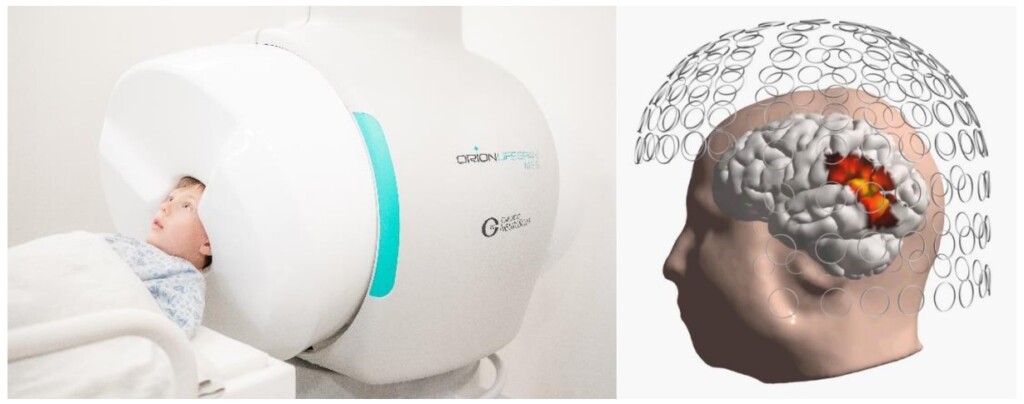
Compumedics Orion LifeSpan MEG system during recording and the resulting functional brain image as shown by CURRY software. Pic: Compumedics
‘Most advanced MEG capability anywhere in the world’
Professor Xuejun Bai is Vice President of TJNU, Head of the MEG Laboratory, Director of the Brain Functional Imaging Centre and former Director of the Chinese Psychological Society. He studies human development using modern technologies such as eye-tracking, event-related potentials (ERPs), functional near-infrared spectroscopy (fNRIS), functional Magnetic Resonance Imaging (fMRI) and now MEG. His research focuses on the psychological mechanisms of children’s reading ability; learning efficiency; mental health; and the development of positive interventions. Prof. Bai has published more than 300 scientific papers and has been awarded ten patents. Prof. Bai commented:
“The Orion LifeSpan MEG recently installed by Compumedics at TJNU has been a revolution in our ability to study mental processes of both children and adults, or even the two simultaneously. The system has already proven itself to be extremely sensitive, accurate and reliable. My team have been hard at work doing MEG measurements, analyzing the resulting data and uncovering new neuroscientific findings. I can say without reservation that the Orion LifeSpan has given TJNU the most advanced MEG capability anywhere in the world.”
Ability to Accurately Scan Both Children and Adults
MEG is a functional neuroimaging technique for mapping brain activity. It uses highly sensitive detectors to record the naturally occurring magnetic fields produced by electrical current flows within the brain. A key principle of MEG is that because magnetic fields drop off very rapidly with distance, the sensors should be as close as possible to the sources of the brain signals. Since the sensors must be within a rigid helmet shape, a child’s small head in an adult size helmet results in sensors far from the brain. This leads to small signals and a poor signal-to-noise ratio (SNR). A dedicated smaller helmet yields clearer and more accurate data. More precise data always leads to better research understanding and improved patient outcomes.
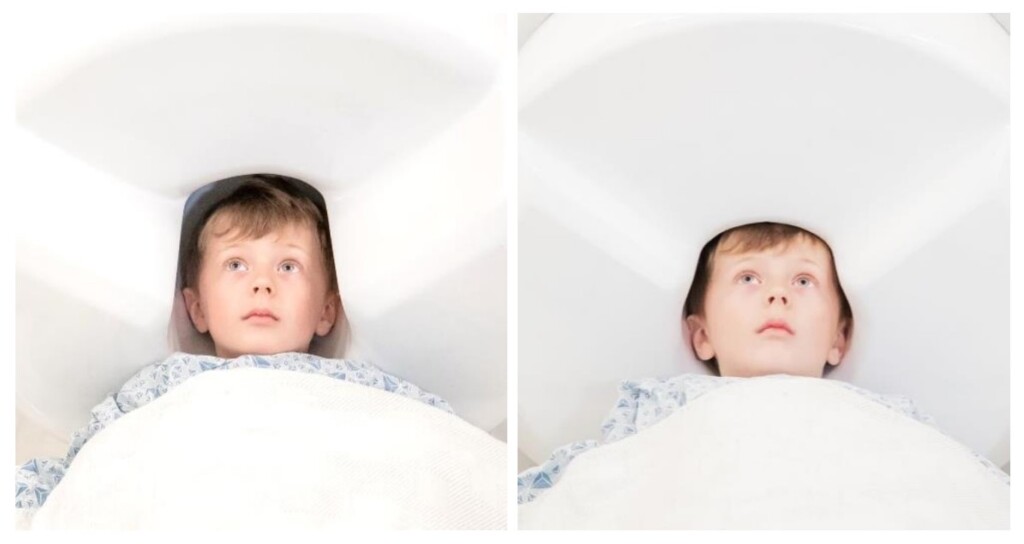
Five-year-old child in an adult sized MEG helmet (left) and the same child in a helmet optimized for pediatric measurements (right). Pic: Compumedics
Achieving Results Where Others Fall Short
Many research and clinical MEG measurements must be done with children, most importantly for pediatric epilepsy diagnostics. For this reason, several manufacturers have in the past produced MEG systems with a pediatric optimized helmet. However, doubling the cost and space requirements to have a second system installed has made these types of systems a rarity. For this reason, Compumedics, along with its technology partners at the Korea Research Institute of Standards and Science (KRISS), developed the unique Orion LifeSpan™ MEG with dual sensing helmets. The system can be installed so that it can rotate and fit within a standard-sized magnetically shielded room, as shown here:

Orion LifeSpan™ MEG in adult measurement position (left), being rotated (center) and in pediatric measurement position (right). Pic: Compumedics
Alternatively, the system can be installed with a bed at each end to permit hyperscanning, as shown here during a visual stimulation task:

Orion LifeSpan™ configured for hyperscanning. Father and daughter subjects are measured simultaneously to study interactions. Synchronization of the sensors in the two helmets is within 1 msec. Image: Compumedics
World’s First Recordings
After installation of the Orion LifeSpan™ MEG at TJNU, a series of measurements were undertaken to demonstrate that the theoretical advantage of the system during pediatric recordings would be borne out in practice. All recording and analysis of the data was performed with the CURRY® signal processing and source localization software suite, an advanced and comprehensive tool for multimodal neuroimaging. One of CURRY®’s key strengths is combining functional data such as EEG and MEG with structural data from MRI and CT to optimize source reconstruction. CURRY® software is FDA-cleared and CE-marked.

Child’s head and brain visualized with MEG sensors (blue circles). The top row shows the head within a standard adult-sized helmet and the bottom row shows the head within an optimized pediatric-helmet. The reduced brain-sensor distance is evident. Image: Compumedics
Founder and Executive Chairman Dr David Burton commented:
“These recordings represented the first time a single MEG system had delivered high-quality scans for both children and adults. This breakthrough was at the world’s most advanced MEG lab at TJNU, which is equipped with a Compumedics Orion LifeSpan MEG system.
“Compumedics has invested nearly a decade and many millions of dollars to develop the Orion LifeSpan MEG,” he said. “The system represents a major leap in magnetoencephalography, with dual-helmet capability for pediatric and adult brain scanning, fully integrated with our gold-standard brain analytics CURRY software.
“It’s incredibly rewarding to see these efforts translating into strong initial sales, global interest and the potential for improved brain health, among both children and adults worldwide.”
A four-year-old female was presented with a series of 200 tones in one ear during an MEG recording in the pediatric helmet. After a break, the measurement was repeated in the adult helmet. The results were averaged and filtered as typical for MEG recordings. The results showed a significantly better SNR in the recording performed in the pediatric helmet. Localization of the resulting data showed more precise determination of where the brain had been activated by the tones. The physics of magnetic field decay and the design philosophy of the Orion LifeSpan™ MEG were confirmed. Furthermore, this study represents one of the first times when a pediatric recording has ever been made in a dual-helmet MEG system.
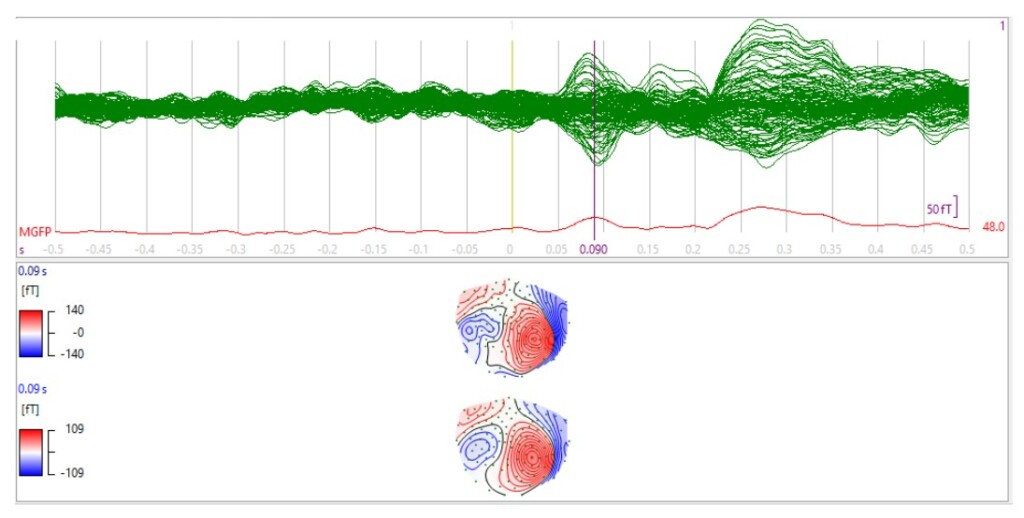
Child in Pediatric Helmet:
Green traces show the signals from the MEG sensors during the child’s listening to tones.The stimulus occurs at time 0 and the clear first response peaks about 0.09 seconds later.The upper color map shows the magnetic fields across the entire head during the recording and the lower shows CURRY®’s calculation of dipolar output that would account for the measured signals.
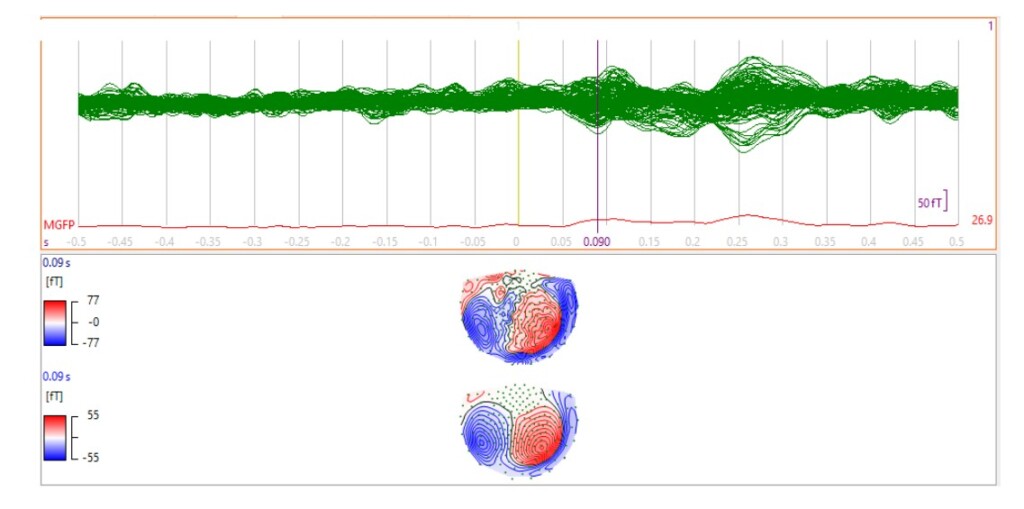
Child in Adult Helmet:
The response from the same child measured in the adult MEG helmet. The traces show much lower amplitude and the map is muddied as a result of the lower signal-to-noise ratio. Images: Compumedics
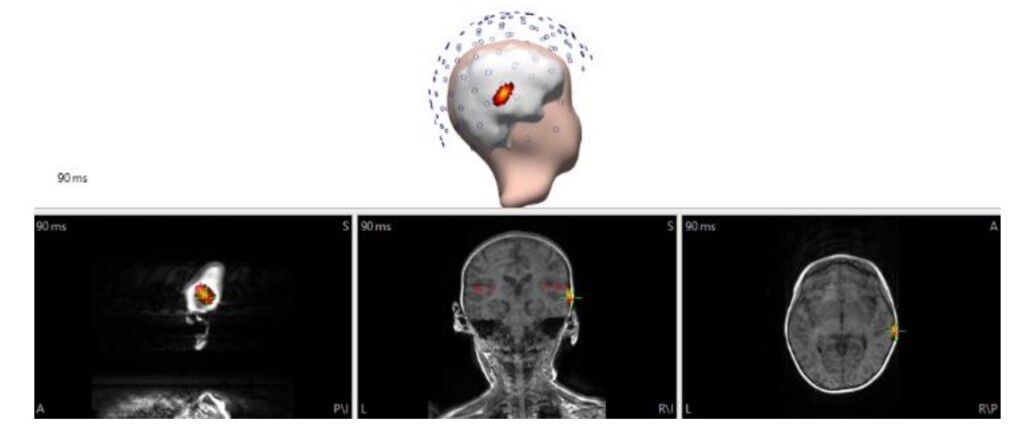
Child in Pediatric Helmet:
The MEG response to the tones with localization calculated by CURRY® (yellow/orange) superimposed on a representation of the subject’s brain (grey). MEG sensor locations (blue circles) are close to the scalp.

Child in Adult Helmet:
The MEG localization is more widespread, indicating greater uncertainty in the measurement, due to the sensors being further from the scalp. Images: Compumedics
About Compumedics Limited
Compumedics Limited [ASX: CMP] is a medical device company involved in the development, manufacture, and commercialization of diagnostics technology for the sleep, brain and ultrasonic blood flow monitoring applications. The Company owns US based Neuroscan and Germany based DWL Elektronishe GmbH. In conjunction with these two subsidiaries, Compumedics has a broad international reach, including the Americas, Australia/Asia Pacific, Europe and the Middle East.
Executive Chairman Dr. David Burton founded Compumedics in 1987. In the same year the Company successfully designed and installed the first Australian, fully computerized sleep clinic at Epworth Hospital in Melbourne. Following this early success, Compumedics focused on the development of products that sold into the growing international sleep clinic and home monitoring markets.
Compumedics listed on the Australian Securities Exchange in 2000. Over the years, Compumedics has received numerous awards, including Australia’s Exporter of the Year, and has been recognized as a Top 100 Innovator by both German and Australian governments.
For further information please contact:
Dr. David Burton
Executive Chairman, CEO
P: +61 3 8420 7300
David Lawson
Director, CFO
P: +61 3 8420 7300
Gordon Haid
Global Neuro-Imaging Business Director
P: +1 604 889 2441 / E: gordon.haid@compumedics.com



